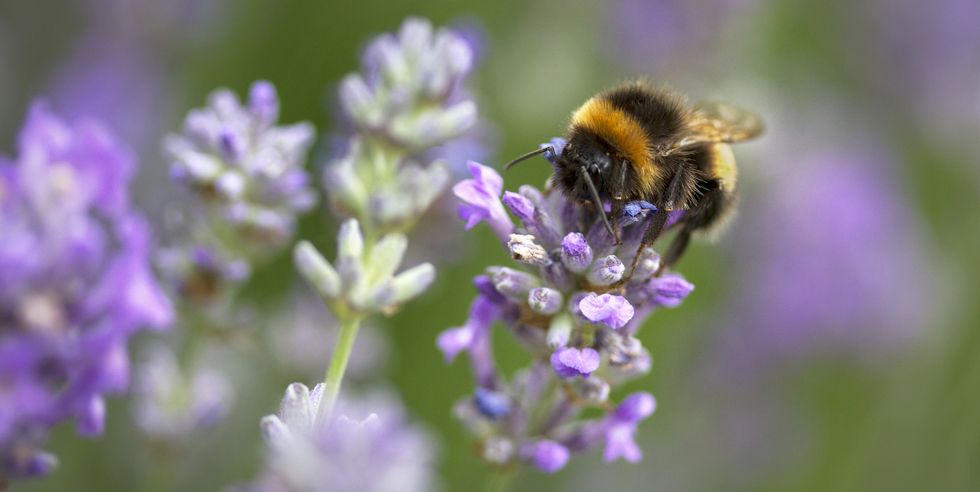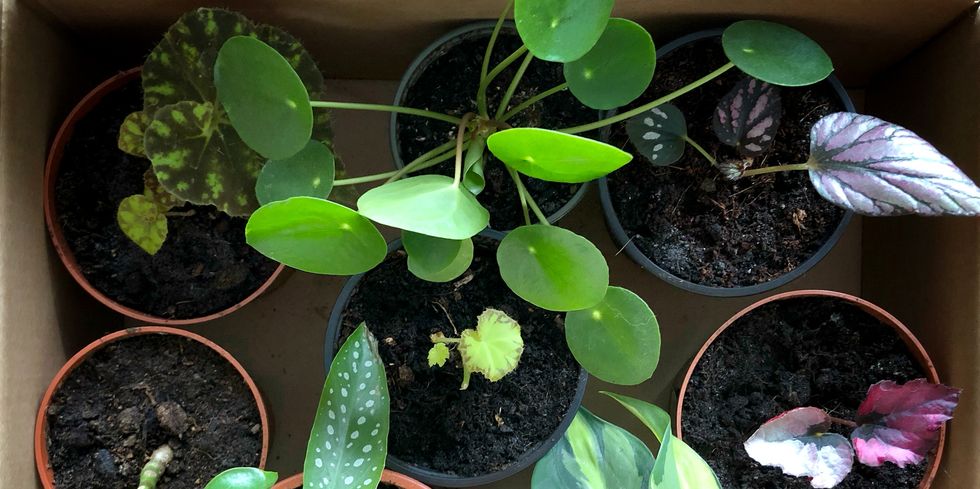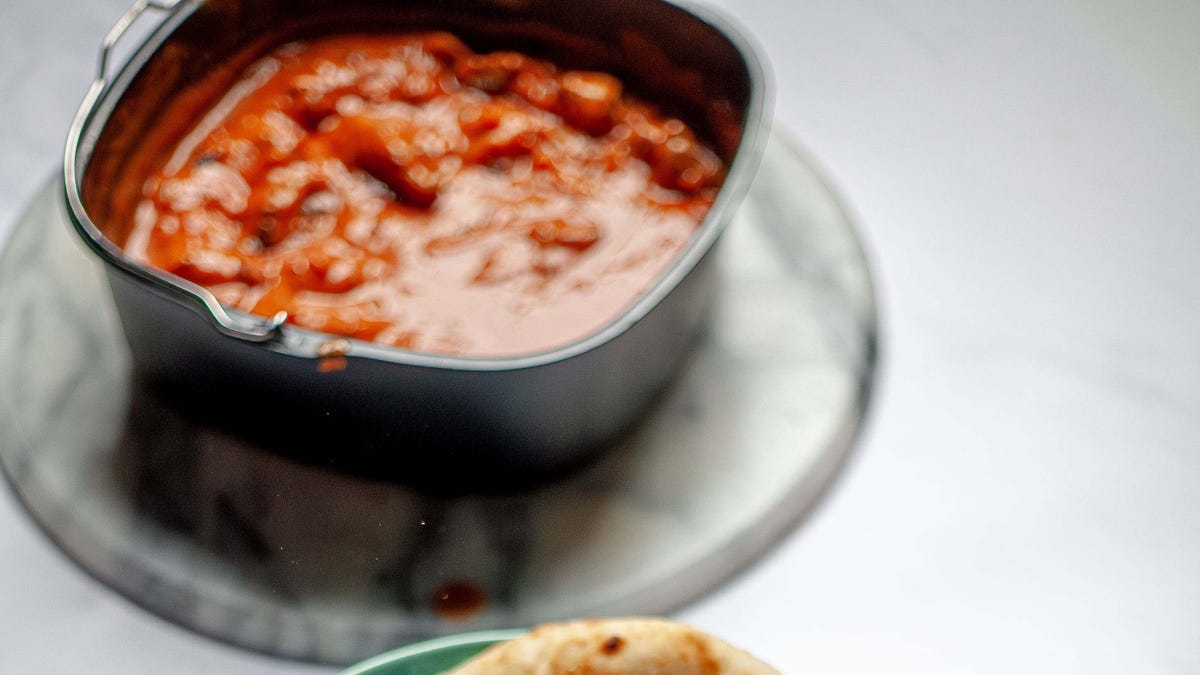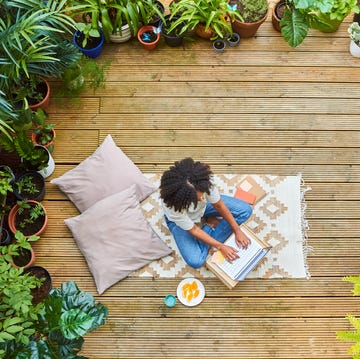For many of us, leading a more environmentally sustainable life is something we try to achieve on a daily basis. We might make an effort to reduce the amount of single use items we use, recycle as much as we can, eat less meat and dairy, buy locally produced food in season or simply walk instead of taking the car when we can. And Good Housekeeping readers are no exception.
In a recent poll, 86% of GH readers told us that they are worried about environmental issues such as climate change, deforestation, plastic pollution and increasing levels of waste.
Knowing what you can do that will actually make a difference isn't always easy, though. With this in mind, we've put together a list of 100 tips and tricks that you can put into practice to help you take action on a range of environmental issues. Some have the added benefit of saving you money, too. If each of us makes even small changes to the way we live, our collective efforts will add up to something much more impactful.
1. Borrow instead of buying
Locate your nearest Library of Things and start borrowing items instead of buying new. You’ll find all sorts of useful, regularly serviced things there, from popcorn makers to pressure washers, and tile cutters to tents – all of which can be hired for a fraction of their retail price. By loaning, not owning, you can help reduce the amount of new material that needs to be sourced and processed to make brand new products and ensure that better use is made of products that are already in existence during their lifespan.
2. Use your local Community Fridge
Food waste is a significant contributor to climate change. Stop perfectly edible food from getting binned by using your nearest Community Fridge. The food stocked in them, often donated by retailers and restaurants just before its use by date, is available to anyone to collect, irrespective of need.
3. Insulate your hot water tank
Insulating your hot water tank can save you £40 a year (£45 in Northern Ireland) on energy bills, according to the Energy Saving Trust (EST), and will reduce your carbon footprint, too. Look for a hot water cylinder jacket that’s at least 80mm thick.
4. Use vinegar to tackle limescale
A great alternative to harsh chemical descalers, distilled white vinegar works wonders on limescale. For shinier, limescale-free taps, soak a cloth in a solution of equal parts distilled white vinegar and water. Wrap it around the tap and leave it to do its thing overnight. Remove the cloth, rinse and dry the tap in the morning. To unclog a limescale-crusted shower head, unscrew it and soak it in a solution of equal parts white vinegar and water to banish limescale. Never use vinegar on gold taps, though.
5. Draught-proof windows and doors
Another sustainable living tip which will save energy as well as money is simply draught-proofing doors and windows. It can reduce the energy required to heat your home in the colder months, and could give you an extra £40 in your pocket each year (£50 in Northern Ireland). It all adds up!
6. Opt for peat-free compost
Peatlands are important in fighting climate change as they absorb and store carbon from the atmosphere. For that reason, peat is best left where it is rather than being dug up for use in compost. Check compost is labelled ‘peat-free’ – a government ban on peat-based compost is due to come into force by the end of this year.
7. Plug in when your energy supply is greenest
Use the National Grid's When to Plug In app to predict when there will be the most renewable energy available in your area. Time when you run the dishwasher, washing machine or tumble dryer accordingly to cut your household's carbon footprint.
8. Buy more sustainable fish
In the UK, we largely eat just a handful of fish and seafood: cod, haddock, tuna, salmon and prawns. But our preference for these particular types of fish and seafood is fuelling overfishing. Check the Marine Conservation Society's Good Fish Guide for a wider range of sustainable alternatives to take some of the strain off these stocks and support local fishermen.
9. Make sure your old gadgets get recycled
In the UK we produce more e-waste (electronic waste) per person than any other country in the world except Norway. When your gadgets come to the end of their life, make sure they end up being recycled either via your local authority’s kerbside e-waste collection scheme, if it has one, or by taking it to your nearest e-waste collection point. Alternatively, if you’re buying a new iPhone, or another Apple product, you could receive a gift card if you return your old Apple tech directly to Apple for refurbishing or recycling. Currys PC World offers a similar recycling scheme for gadgets including phones, toasters, TVs and floor cleaners.
10. Choose recyclable gift wrap and greeting cards
When you shop for gift wrap and greetings cards, avoid anything embellished with foil or glitter as it can’t be recycled. Thick, glossy wrapping paper is likely to have been laminated, which means it can’t be recycled either so steer clear of this, too. When you receive a gift, use the "scrunch test" to check if the gift wrap it came in is likely to be recyclable – if it stays scrunched, it probably is. Don’t forget to remove sticky tape before adding the paper to your recycling bin.
11. Keep your toilet smelling fresh
Instead of reaching for the bleach or a harsh chemical toilet cleaner when you want to freshen the toilet bowl, pour a cup of bicarbonate of soda down the loo once a week to naturally neutralise odours. Leave overnight then flush away.
12. Clean your microwave the eco way!
Heat a small, microwavable bowl of water in the microwave until the inside of the microwave looks steamy. Let the steam clear a little then wipe down the inside surfaces of the microwave with a clean cloth. Add a few slices of lemon to the water before heating it if your microwave needs freshening up.
13. Reduce microfibres released in the wash
The microfibres that are released when we wash synthetic clothes and other textiles, can end up polluting our seas and oceans. Wash synthetics in a GuppyFriend laundry bag, as research by scientists at the University of Plymouth showed it caught just over half of the synthetic microfibres that are released during a wash. Selecting a slower spin speed and washing at lower temperatures and shorter cycles also helps.
14. Make your own cleaning cloths
When pure cotton T-shirts and towels come to the end of their life, use a pair of sharp scissors to cut them into cleaning cloths. Squares roughly 40 x 40cm in size will make a great addition to your cleaning kit.
15. Descale the kettle the green way
You don’t need to use a harsh chemical descaler to keep your kettle in good working order - this is another job that distilled white vinegar is more than up to tackling. Fill the kettle with half white vinegar and half water and leave for a few hours. Empty and rinse thoroughly before making your next cuppa.
16. Mulch your flower beds
To help your borders retain as much moisture as possible throughout the growing season, apply a mulch such as bark chippings or gravel in the spring when the ground still has plenty of water in it. You’ll need to use less water to keep your garden looking its best in the summer months.
17. Approach "compostable" claims with caution
If you’re buying something that claims to have compostable packaging, make sure it’s certified home compostable before you add it to the compost bin. If it is, it will usually have a logo to prove it and this shows it will break down in the conditions you tend to find in a home compost bin. Don’t assume you can add home compostable film or other packaging to your local authority food waste collection. Some processing plants will reject home compostable packaging if their facilities haven’t been designed to handle it.
18. Plant perennials
Opting for perennials in your borders, rather than buying and planting annuals each year means you're saving the resources that would have been used to grow them and potentially cutting down on plastic waste from plant pots. If you do want to grow some annuals in your beds, try growing them from seed (preferably seed collected from last year's plants) instead.
19. Switch to more eco-friendly coffee pods
Love the convenience of your pod coffee machine but hate the waste? Give the refillable, stainless steel Evergreen Reusable Capsule (from £27) a go if you have a Nespresso or Nespresso-compatible machine. Simply fill it with your favourite ground coffee – a 250g bag should be enough to make around 35 single shot coffees.
20. Make your own compost
Even if you’ve cut down on food waste at home, there will still be some non-edible things such as peelings, stems and leaves that will end up in your food waste bin. Unless, that is, you have a home compost bin to add them to. Not only will making your own compost help put some of the contents of your kitchen caddy to good use, it could also save you money on bags of compost from the garden centre.
21. Use greener methods to clear drains
While powerful liquid drain unblockers are handy in an emergency, many are harmful to aquatic life. With a little regular maintenance, however, you should be able avoid having to use them too often. Clear a stubborn drain by pouring 125g of bicarbonate of soda down it followed by 125ml vinegar. Cover with a wet cloth, wait 5 minutes, and then flush with hot water. To keep sinks and basins draining freely, pour a mug of soda crystals down the plughole regularly, then flush with boiling water.
22. Recycle contact lenses and packaging
If you wear contact lenses, the Acuvue recycling scheme allows you to drop off the packaging, and the used lenses themselves at over 1,000 locations, including 600 Boots Opticians as well as some independent stores. They take any brand as long as they’re soft lenses. This map will help you find your nearest drop-off point.
23. Buy loose fruit and veg
A simple way to cut down on single-use plastic in your weekly shop, is to opt for loose fruit and veg instead of bagged produce. Take your own reusable produce bags with you if you find this more manageable.
24. Avoid palm oil
Palm oil is found in a huge range of products, from bread to ice cream. But the way it’s farmed has been linked to rainforest clearance. Make your voice heard on this issue by switching to palm oil-free products. Diana Ruiz, Greenpeace forest campaigner, explains why this will have more impact than buying products with sustainable palm oil logos: “If you want to take a stand on palm oil, don’t be swayed by sustainability logos. These certification schemes have proved to be unreliable. You may be better off avoiding products with palm oil until your favourite brands can prove the palm oil hasn’t contributed to deforestation or human rights abuses.”
25. Use a microfibre cleaning cloth
Using a microfibre cloth when you clean makes it easier to cut back on your use of branded cleaners and the number of chemicals you’re introducing to your home and flushing away through your waste water pipes every time you wash your cleaning cloths.
26. Switch gadgets and appliances off when not in use
We all know that switching the light off when you leave a room helps save energy, but don’t forget that switching off electrical devices at the wall socket also makes a difference.
27. Brush up on recycling rules
What is accepted in local kerbside recycling collections is notoriously inconsistent across the UK. That might not seem like more of an inconvenience than a problem, but if you put items made from materials that aren’t actually accepted for recycling in your area in your recycling bin, you risk contaminating the entire load, which could then be sent for incineration or too landfill. Check your local authority's website regularly to make sure you're on top of what's recycled and what isn't in your area.
28. Measure your carbon footprint
If you’re trying to reduce your carbon footprint (the amount of CO2 emissions your lifestyle produces), there’s a growing number of apps that can help you. Try the AWorld app, Giki app or WWF’s My Footprint app to help you keep tabs on how you’re doing and make greater savings.
29. Recycle cosmetics packaging
Unfortunately, there are still plenty of things that aren’t widely accepted in recycling collections, often because they’re made of several different materials and this makes them hard to process. If you’re not sure what to do with cosmetics packaging, check out the Boots cosmetics recycling scheme. If you take five empty pieces of cosmetics or dental packaging into a participating store, you’ll get 500 Boots Advantage Card points (worth £5) next time you spend £10 or more. You’ll have to register online first to participate in the scheme.
30. Recycle at your garden centre
Plastic waste from black plant pots and seed trays or compost bags generally isn't recyclable through kerbside collections. However, a growing number of garden centres, including Dobbies, Notcutts and Squires, have collection points for these tricky-to-recycle items.
31. Make the most of your freezer
When it comes to fighting food waste, your freezer might just be the best weapon in your arsenal. Use it to store any food you won’t get around to eating before it spoils and prioritise the foods in your fridge that don’t freeze well instead.
32. Switch to eco-friendly washing up liquid
These days eco-friendly washing up liquid works just as well as conventional liquid. In fact, in our most recent tests of all types of washing-up liquid, an eco liquid came out top. Bower Grapefruit Washing Up Liquid Refill (89/100) comes in a recyclable pouch refill to cut down on plastic waste.
33. Plant bee-friendly plants
Bees play a key role in pollinating the flowering plants that we rely on for food. For the green-fingered among us, planting bee-friendly flowers such as abelia, lavender and honeysuckle will give them the nectar they need to survive and thrive.
34. Look out for "green van" delivery options
When you shop for groceries online, check whether there is a "green van" delivery slot available. This means your shopping will be dropped off to you when there’s already a van making deliveries in your area. This can reduce the carbon footprint of your online order, and the vehicle emissions of the van bringing it to you, by over a tenth, according to research by the Rotterdam School of Management. Sainsbury’s and Ocado both offer "green van" slots.
35. Make the most of what you’ve got!
Each year in the UK we send 350,000 tonnes of clothing to landfill but by buying second hand, buying better and buying less and finding new ways to style the clothes you already own, you can help change things. "The most sustainable clothes are the ones already in your wardrobe. Extending the lifespan of a garment by nine months can reduce its carbon footprint by 20-30 per cent, so follow the #30Wears rule and take pride in every re-wear," advises Lauren Bravo, author of How To Break Up With Fast Fashion.
36. Use a portion calculator
Knowing the exact quantities of ingredients you need for a meal can prevent unnecessary food waste. This portion calculator from Love Food Hate Waste means you won’t need to guesstimate portion sizes so you won’t buy or cook more than you need. Just pop in the food you’re cooking and the number of servings.
37. Ditch branded multi-surface cleaners
Using vinegar to clean surfaces can be a greener alternative to branded cleaners and could save you money. Make up a spray bottle of half white vinegar and half water, and use it as regularly as you would a general bathroom cleaning spray on tiles, basins, baths, showers and taps to keep limescale at bay (never use vinegar on gold-plated taps). Always rinse thoroughly with water afterwards.
38. Get more life from your washing machine
Replacing your washing machine every five years produces 1.1 tonnes more carbon dioxide than keeping a machine running for two decades. Descaling your washing machine regularly can help it last longer, especially if you live in a hard water area. Use a large cup of white vinegar or lemon juice in place of your usual detergent and run the machine empty on a normal cycle.
39. Repair rather than replace
Sometimes it’s cheaper to replace an appliance or a small electric product rather than repairing it, but this can add to the growing problem of electronic waste. Recent "right to repair" laws mean manufacturers have to make spare parts available for an appliance for a minimum of seven to ten years after that appliance has been discontinued. In theory, this should make it easier to repair the appliances we rely on in our homes. Always get a quote to see if a repair will be cost-effective before writing off an appliance and buying another.
40. Get clever with leftovers
Repurposing leftovers is a great way to prevent food waste and stretch your money further. The Good Housekeeping Cookery Team have 22 creative and tasty recipes for using up leftover chicken — just make sure that you store and heat your food properly to avoid food poisoning.
41. Clean your windows the green way
Making your own window cleaner can be a green, ammonia-free alternative to branded cleaners. Try creating your own cleaning solution by adding one part distilled white vinegar to nine parts water in an old spray bottle. Spray your windows, wipe clean, then buff dry with a microfibre cloth. You can also see a round up of ready-made soluble cleaning products for reducing plastic waste.
42. Take your own plant cuttings
The government ban on peat-based compost that comes into force in 2024 only covers the compost you buy in bags – for now. To reduce the number of plants you buy that may have been grown in peat-based compost, take cuttings and swap them with friends.
43. Look for locally grown, seasonal produce
Food that's grown in the field when it's supposed to grow, and not in heated, covered conditions, is more likely to have a smaller carbon footprint. Buying fresh produce grown abroad at other times of the year isn't necessarily an environmentally unsound option if it's been grown in the field, in season there. If you want to limit the carbon emissions associated with the production and transportation of your food, though, you should always avoid highly perishable fruit and veg such as berries and beans, that have been air-freighted from far flung destinations.
"What we eat has a huge impact on the planet. Choosing food that is local, seasonal and traceable can help reduce food miles, carbon emissions and our impact on nature. Try buying from a local farm shop, box scheme or farmers' market when you can," says Adele Jones, deputy CEO of the Sustainable Food Trust.
44. Ditch liquid floor cleaner
Make light work of scrubbing the decks by buying a machine-washable e-cloth Deep Clean Mop. The only liquid you’ll need is water.
45. Be wary of "biodegradable" claims
It may reassure you to see "biodegradable" on packaging, but sadly, there’s little to back this claim up. Anything claiming to be biodegradable should break down into natural materials, but there’s no saying how long this will take. Instead, look for "home compostable" certification, which has stricter criteria about the time it should take something to break down in the conditions typical of a garden compost bin.
46. Get help to eat more veg
Cutting down on meat may feel like a challenge, but the Optimise Meat Tracker could give you a helping hand. It allows you to record how much meat you ate the previous day and set a goal for lowering your consumption over the next 24 hours. You can set challenges like “try a meat-free alternative” or “double the amount of veg and half the meat” that make your goals feel more achievable.
47. Use alternatives to floral foam
Floral foam contains the same amount of plastic as ten whole shopping bags, is non-recyclable and can even be toxic for humans and animals. Try supporting flowers with pebbles, sand, gravel, marbles or compact moss for a greener alternative.
48. Eco-friendly alternatives to cling film
British households use enough cling film each year to wrap around the globe 30 times but this single-use plastic takes hundreds of years to degrade. Pop leftovers or fresh food into reusable food storage boxes instead or into a bowl with an upturned plate on top. Alternatively, Eddington Bee’s Wraps are made from beeswax, organic cotton, tree resin and jojoba oil.
49. Don’t leave things on standby
Many of us are guilty of leaving appliances on standby instead of switching them off. According to Energy Saving Trust, 9-16% of electricity in our homes is used to power devices on standby. Turning things off, particularly TVs, computers and games consoles, could reduce your usage - and your carbon footprint - considerably.
"Standby power is the electricity used by appliances when they’re switched off or on 'rest mode’ explains Chris Saunders, household energy expert and founder of LoopEnergySaver.com. "Almost any product with an external power supply, remote control, display or which charges batteries will draw some power continuously unless shut down or switched off at the mains."
50. Install a smart meter
Over 22 million households have smart meters installed, allowing them to have their meter readings sent to them automatically. It’s an easy way to monitor your energy usage and make more energy-efficient choices. Best of all, it’s completely free!
51. Return fewer items
"Bracketing" is a trend where people buy multiple items of clothing online with the intention of returning some of them. Unfortunately, the majority of these clothes end up in the landfill as it’s cheaper and easier for the company to scrap them than to put them back on sale. If you’re particularly worried about finding something your size, try to go to a physical store to try on a garment or go for second-hand clothes to lessen your impact.
52. Choose plastic-free tea
You’d be surprised to find that many tea bags are made using a plastic sealant. Not only does this make them non-biodegradable, but it also means that plastic is leaking into our brews and digestive systems. Opt for loose leaf tea instead, buy in bulk to limit packaging and buy a few metal tea strainers. If loose leaf tea tea sounds like too much of a faff, look for plastic-free tea bags, such as Clippers.
53. Get your milk delivered
Take a minute to consider how many plastic cartons of milk you buy each month… now, perhaps it’s time to go old-school and book a weekly delivery from the milkman? To find out if one is making their round (of glass pint bottles) near you, visit the Find me a milkman website.
54. Refill, refill, refill
It’s easier than you may think to cut down on plastic during your food shop. Bringing refillable containers to a zero-waste store allows you to buy dried goods like coffee, nuts and spices without the unnecessary packaging. The Refill App can help you scope out plastic-free produce in your area.
55. Give soluble cleaning products a go
Soluble cleaners dissolve in water, meaning that they require less packaging and fuel to transport. They are often sold in refillable bottles so you can reduce your plastic usage as well as your carbon footprint!
56. Remember your reusable bag
Reaching the tills and realising you’ve forgotten your reusable shopper is annoying and we’ve all been there. In fact, according to BRITA research, 37 per cent of us admit to feeling guilty about forgetting to bring a reusable carrier bag to the shops. So we recommend choosing a fold-up bag that fits in your pocket or purse. Problem solved.
57. Have a greener period
The Women’s Environment Network has found that your period product of choice could be up to 90 per cent plastic, which is equivalent to four plastic shopping bags in just one pad. Over a lifetime, that's a whopping 44,000 plastic bags worth of period-related-plastic-waste per person. The solution? Use compostable organic cotton tampons and pads, reusable menstrual cups, period pants and pads, or even Dame’s reusable tampon applicator.
58. Rethink how you store your fruit
Reducing food waste can be as simple as rethinking how you store your fruit. Keeping your bananas in a bunch means that they will ripen at the same time, causing you to either eat them all quickly or throw away the ones that go bad — breaking up the bunch will prevent this. And the term "bad apple" exists for a reason! Storing apples in a fruit bowl can spoil the other fruit, so keeping them separate can keep your produce fresh for longer.
59. Invest in the future
By avoiding banks that invest in the fossil fuel industry, you can use your savings to protect the planet. Ethical banks such as Triodos Bank, Ecology Building Society, Charity Bank, The Co-operative Bank and Reliance Bank do not invest your money into oil, coal or gas industries. Placing your money in an ethical investment fund will also allow your savings to contribute towards caring for the planet.
60. Give pre-loved gifts
Although 41 per cent of GH readers say they’re happy to buy second-hand goods for themselves, a recent survey by pre-loved marketplace Vinted showed that only one in six of us would be prepared to give someone a second-hand gift. Buck the trend by looking out for vintage treasures in your local charity shop or antiques fair or browse the pre-loved wares of online sellers on eBay, Vinted, Etsy or charity websites such as Oxfam.
61. Buy a reusable water bottle
You might be surprised – and perhaps horrified – to learn that only about a tenth of the single-use plastic we use in the UK is actually recycled. Say 'no' to one type of single-use packaging by investing in a refillable water bottle. In our most recent tests of reusable water bottles, the Chillys Series 2 Water Bottle (500ml, £36 from Amazon) was one of our top picks.
62. Don’t let your unused food go to waste
Download the free Olio app (Apple, Android) and join the network of Olio users in your area who share food they’re not going to use with others. See our roundup of the best green apps for more sustainable living.
63. Use a keep-cup
Invest in a reusable coffee cup and take it with you when you buy your daily brew. Not only will it cut down on waste from disposable cups, but it could also save you money. Costa will give you a discount of 25p every time you use a reusable cup, while Pret a Manger will take 50p off the cost of your coffee. Other coffee shops offer similar discounts, too, so it’s always worth asking.
64. Give preloved and vintage clothes a second life
Clothes production has a huge impact on the environment, with a pair of jeans typically using nearly 1,800 gallons of water to produce! Waste Less Live More suggest that wearing something for an extra nine months can reduce its carbon footprint by up to a third.
Luckily, there are tons of great options for getting your hands on used and vintage clothes. Become acquainted with your local charity and antique shops or even have a clothes swap with a friend. ASOS Marketplace, Depop, Vinted and eBay are great platforms for browsing vintage collections, allowing you to support smaller boutiques and emerging businesses.
65. Buy local
From food to furniture, every product racks up a higher carbon footprint the further it travels. So if you're going to the shops, why not walk to and from a local farmers' market, antique store or independent clothes shop? This is a great way to get exercise in, lower your carbon footprint and support smaller local businesses.
66. Reuse plastic plant pots
If you’re a keen gardener, you may often find yourself faced with the problem of what to do with plastic plant pots once the plants they once contained have been added to your borders or hanging baskets. While many local authorities will collect terracotta or taupe pots in kerbside plastic recycling collections, black plastic pots can’t currently be processed. A greener move - whatever the colour of the pot - is to reuse it as many times as possible to take cuttings or pot on smaller plants.
67. Buy the most energy efficient appliances you can afford
Energy efficiency ratings for appliances changed in March 2021, and the scale now runs from A-G. Even an appliance that would have scored the highest rating of A+++ under the old system will probably only have a rating of C or possibly B under the new one.
68. Grow your own!
When we buy fruit and vegetables from the supermarket, we often forget about the long journey they’ve taken to get there — this distance is referred to as “food miles”. Growing your own food is not only a nice hobby, it will also allow you to lessen the environmental impact of your plate.
69. Choose green delivery options when you shop online
We all love online shopping for the convenience, but did you know opting for "click and collect" can make your shopping greener? Picking up your parcel from a store, locker or petrol station instead of having it delivered to your doorstep can reduce carbon emissions if picking it up doesn’t involve a car journey — and the same goes for returning items.
70. Opt for organic
Organic food is produced without the pesticides that can harm soil quality. Organic farms are also a haven for wildlife. Organic food tends to be pricier than non-organic alternatives but even buying whatever organic food your budget will stretch to is a step in the right direction.
71. Don’t always choose the fastest delivery option
If you don’t really need the thing you’re buying delivered tomorrow, choose a longer delivery option. Longer delivery times give retailers the opportunity to plan their delivery schedule more efficiently and for this reason they tend to be more eco-friendly. Similarly, try to group deliveries from retailers like Amazon into as few deliveries as possible. Amazon Prime users can select the Amazon Day delivery option (free) to help with this.
72. Make your next car an electric one
The government has said it will end the sale of petrol and diesel cars in 2035. After the year we’ve had with fuel shortages, an electric car might be more tempting than ever, and can help you shrink your carbon footprint.
73. Choose more sustainable chocolate
Much as we all love chocolate, it's an uncomfortable truth that the production of chocolate is linked to environmental issues such as deforestation, and habitat and biodiversity loss, in addition to social issues including forced and child labour. Use the ratings on the Chocolate Scorecard to help you make more sustainable choices when you fancy something sweet.
74. Switch to a green energy tariff
“Electricity generated by burning fossil fuels such as coal and gas directly causes global warming and pollution. At home, you can stop this by simply switching to a tariff or supplier that uses only renewable sources such as wind or solar power,” says Dr Stephen Cornelius, chief adviser on climate change at WWF-UK.
75. Shorten showers
In a household of four, if each person spent a minute less in the shower each day, you’d cut carbon emissions and you could save £80 per year on water and energy bills, according to the Energy Saving Trust.
76. Money talks – find your voice
“Make sure your pension isn’t fuelling climate change by asking your provider where your money is invested. Ask them what "green" pension options they have that better align with your interests,” advises Tony Burdon, CEO, Make My Money Matter.
77. Tackle food waste with the Too Good to Go app
The Too Good to Go app (free, Apple and Android) tells you when a "lucky dip" bag of unsold food from supermarkets, cafes and restaurants is available to buy near you for a snip. A bargain for you and good for the planet to boot!
78. Have a water meter fitted
Households with a water meter use around 30 litres of water per day per person less than households without one. Your water supplier should provide and fit one free of charge if you request it, providing there are no changes needed to your existing plumbing.
79. Plan meals
Instead of filling your fridge with food items you’ll forget about until they’re out of date, plan your meals for the week before you do the weekly shop so you only buy what you need. If you find yourself with a glut of fresh food, prioritise using up the things that will go out of date first to minimise waste.
80. Cut down on meat and dairy
Land that is cleared to grow our food contributes to as much as 80 per cent of global deforestation, according to Greenpeace. Cutting down on chicken and pork as well as red meat can help, as the animals the meat is from may be fed feeds containing soya. In fact, around 90 per cent of the soya the UK imports from countries such as Brazil and Argentina – where forests are cleared to grow it – is used as feed.
81. Buy grass-fed meat
Animals that aren’t grass fed will have a diet of feed that may contain soya, a crop that can be farmed in a way that contributes to the destruction of the rainforest. Meat labelled as "grass-fed" comes from animals fed 51 per cent grass or more (they may still also be fed animal feeds containing soya). Animals raised to produce organic lamb or beef must have been fed at least 60 per cent grass. Try online suppliers such as Pipers Farm for 100 per cent grass-fed beef and lamb.
82. Choose rainforest-friendly products
To make sure what you’re buying hasn’t been grown in a way that contributes to deforestation, look for the Rainforest Alliance certification logo – particularly on products such as chocolate or coffee.
83. Buy better, buy less
Over half of GH readers (57 per cent) say they buy things they think will last longer, even if they cost a bit more. Thinking about the longevity of the things we buy can help reduce waste and means that resources aren’t used up making new products to replace ones that come to the end of their serviceable life earlier than they should.
84. Turn off lights
So obvious but so easy to forget! By turning off lights when you’re not in a room you could save around £14 a year on electricity, according to the Energy Saving Trust.
85. Give the Kitche app a go
This clever app (free, Apple and Android) lets you scan supermarket receipts or upload receipts from online shopping so you always know what food you already have in your kitchen. It suggests recipes to use up ingredients and will give you a heads-up when food is nearing its "use-by date" to help reduce food waste.
86. Cut down on single-use plastic
“Most microplastics in our seas and oceans come from larger items of plastic litter, which break down into smaller fragments over time. You can help by minimising your use of single-use plastic and making sure you dispose of plastic properly – ideally by recycling,” explains Richard Thompson, International Marine Litter Research Unit, University of Plymouth.
87. Never flush wet wipes down the loo
Check the packaging of wet wipes and cosmetic wipes for the Fine to Flush logo. If you don’t see it, bin each wipe after use rather than flushing it. Only wipes that are plastic-free and have passed tests to show they break down completely in the sewer system can display the Fine to Flush logo. Other wipes that are mistakenly flushed down the loo can cause 'fatbergs' and or end up littering beaches when sewers overflow.
88. Try an eco-friendly veg box
When we tested fruit and veg delivery boxes, Daylesford's organic Market Garden Veg Box (£15) came top with a score of 96/100 . Our runner-up was the Abel & Cole Organic Small Fruit & Veg Box (£15, 89/100), which gives you the option of specifying three fruits and seven veggies you'd rather not receive.
89. Recycle water to use on your plants
“Use water sparingly in the summer months. If you don’t have a water butt, place containers in the garden to catch rainwater to water thirsty plants or use recycled water from the bath or sink. Just don’t use soapy water on edible plants,” advises Lydia Makin, of water charity Waterwise.
90. Rethink how you approach "best before" dates
Just because food is past its "best before" date, doesn’t mean it’s ready for the bin. Food waste is responsible for a sizeable chunk of our greenhouse gas emissions, which contribute to climate change.
91. Switch to an eco-friendlier laundry detergent
In our most recent tests, the winning bio detergent was Ecover Concentrated Bio Laundry Detergent (£8.40 for 1.5litres from Amazon) with a score of 91/10. It proved tough on stains but kind on colours in our tests. If you prefer a non-bio, try Smol Non-Bio capsules (90/100, £6 for 24 capsules).
92. Buy water efficient appliances
In the market for a new dishwasher or washing machine? Switching to water efficient appliances can help you reduce water waste and reduce your monthly bill. When checking out new appliances, look for the water consumption figure on its energy efficiency label — this will tell you how much water the appliance uses per cycle so you can compare products before you buy.
93. Collaborate
“Feeling you have to fight climate change or protect nature alone can be overwhelming. Join or organise a community event to talk about local sustainability issues – you’ll be amazed what you can achieve with others,” says Alasdair Roxburgh, director of communities and networks at Friends of the Earth.
94. Make energy efficiency improvements at home
The Simple Energy Advice "Plan Home Improvements" tool can help you put together a plan, with ballpark costs for each suggested improvement and potential savings on your energy bills.
95. Buy water-free products
Some products like shampoo bars, hand salves and cleansing balms use less water in their manufacture and can have a lower carbon footprint associated with their transportation.
96. Reduce car travel
Road transport accounts for roughly a fifth of the UK’s greenhouse gas emissions and the government’s Climate Change Committee (CCC) says we need to cut car travel by around a tenth by 2035 to help control climate change.
97. Do your homework when it comes to green energy
It’s not always easy to tell just how eco-friendly one green energy tariff is compare to another. Use the Uswitch green energy accreditation ratings (they’re independently verified) to find out how eco-friendly an energy tariff is before signing up.
98. Opt for drought-tolerant plants
If you have spaces in your borders, fill them with drought-tolerant plants, such as sedum, lavender and thyme. They’ll need less water to look bloomin’ lovely all summer long. They’re also perfect to plant in raised beds, pots and hanging baskets, which tend to dry out quicker than other spots in the garden.
99. Make sure your fridge is set to the right temperature
The temperature inside your fridge should be 5 degrees or below. This will help keep food fresh for longer, which can reduce food waste - a major contributor to climate change. Check the temperature using a fridge thermometer.
100. Rethink your viewing habits
If you’re streaming video content to a small screen, think about watching in standard definition rather than high definition. You won’t necessarily notice much difference in picture quality and this can reduce the carbon footprint of video streaming by up to 90 per cent. In a similar vein, you can cut the carbon footprint of web conferencing by 96 per cent simply by switching off your camera when you don’t need to use it. Great news on less-than-perfect hair days!















